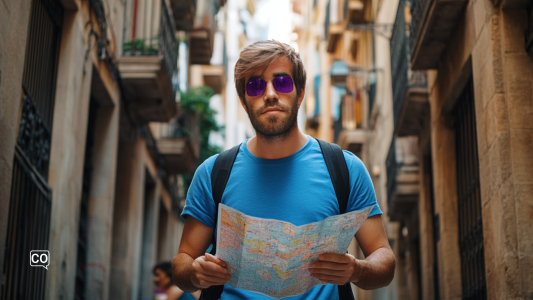¡El mundo es enorme!

Learning goals:
- Situation: Describiendo paisajes (Describing landscapes)
- Situation: Indicando lugares en el mapa (Indicating places on the map)
- Verb: Seguir (to follow) - Presente, indicativo (Present, indicative)
- Verb: Buscar (to search) - Presente, indicativo (Present, indicative)
- Grammar: Las preposiciones de lugar (Prepositions of place)
- Culture: El Tajo y el Ebro: los ríos más grandes de España (The Tagus and the Ebro: the largest rivers in Spain)
Learning module 2 (A2): Naturaleza y medio ambiente (Nature and environment)
Teaching guidelines +/- 60 minutes
Listening materials
Video, audio, exercises and worksheets available.
A2.14.1 Diálogo: Ana y Pedro viajan por el mundo
A2.14.1 Ana and Pedro travel around the world
Ana y Pedro hablan sobre su próximo viaje y exploran el mapa del mundo, buscando islas, playas y cascadas.
(Ana and Pedro talk about their upcoming trip and explore the world map, looking for islands, beaches, and waterfalls.)
Teaching guidelines +/- 15 minutes
A2.14.2 Gramática: Las preposiciones de lugar
A2.14.2 Spanish grammar: Prepositions of place
(Learn the prepositions of place in this lesson using vocabulary related to nature and the environment.)
Teaching guidelines +/- 15 minutes
A2.14.3 Cuento corto: Viajar con un mapa
A2.14.3 Spanish short story: Travelling with a Map
Una historia corta sobre un chico que viaja por el mundo usando su mapa.
(A short story about a boy who travels around the world using his map.)
Teaching guidelines +/- 15 minutes
A2.14.4 Cultura: El Tajo y el Ebro: los ríos más grandes de España
A2.14.4 Spanish culture: The Tagus and the Ebro: the largest rivers in Spain
Descubre cómo los ríos Tajo y Ebro cruzan el país, conectando ciudades y paisajes increíbles.
(Discover how the Tagus and Ebro rivers cross the country, connecting cities and incredible landscapes.)
Teaching guidelines +/- 10 minutes


